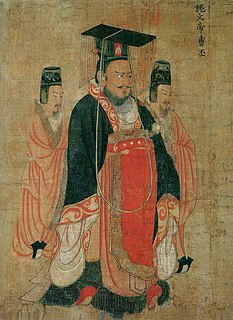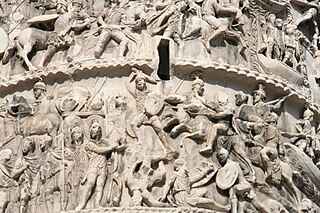Related Research Articles

Titus Aelius Hadrianus Antoninus Pius was Roman emperor from 138 to 161. He was one of the Five Good Emperors from the Nerva–Antonine dynasty.

Marcus Aurelius Antoninus was a Roman emperor from 161 to 180 and a Stoic philosopher. He was the last of the rulers known as the Five Good Emperors, and the last emperor of the Pax Romana, an age of relative peace and stability for the Roman Empire. He served as Roman consul in 140, 145, and 161.
The 160s decade ran from January 1, 160, to December 31, 169.
The 170s decade ran from January 1, 170, to December 31, 179.
The 180s decade ran from January 1, 180, to December 31, 189.
The 190s decade ran from January 1, 190, to December 31, 199.
Year 195 (CXCV) was a common year starting on Wednesday of the Julian calendar. At the time, it was known as the Year of the Consulship of Scrapula and Clemens. The denomination 195 for this year has been used since the early medieval period, when the Anno Domini calendar era became the prevalent method in Europe for naming years.
The 220s decade ran from January 1, 220, to December 31, 229.
Year 190 (CXC) was a common year starting on Thursday of the Julian calendar. At the time, it was known as the Year of the Consulship of Aurelius and Sura. The denomination 190 for this year has been used since the early medieval period, when the Anno Domini calendar era became the prevalent method in Europe for naming years.

Year 193 (CXCIII) was a common year starting on Monday of the Julian calendar. At the time, it was known as the Year of the Consulship of Sosius and Ericius. The denomination 193 for this year has been used since the early medieval period, when the Anno Domini calendar era became the prevalent method in Europe for naming years.

Year 180 (CLXXX) was a leap year starting on Friday of the Julian calendar. At the time, it was known as the Year of the Consulship of Rusticus and Condianus. The denomination 180 for this year has been used since the early medieval period, when the Anno Domini calendar era became the prevalent method in Europe for naming years.
Year 177 (CLXXVII) was a common year starting on Tuesday of the Julian calendar. At the time, it was known as the Year of the Consulship of Commodus and Plautius. The denomination 177 for this year has been used since the early medieval period, when the Anno Domini calendar era became the prevalent method in Europe for naming years.

Commodus was a Roman emperor serving jointly with his father Marcus Aurelius from 176 until his father's death in 180, and solely until 192. His reign is commonly thought of as marking the end of a golden period of peace in the history of the Roman Empire, known as the Pax Romana.

Year 220 (CCXX) was a leap year starting on Saturday of the Julian calendar. At the time, it was known as the Year of the Consulship of Antonius and Eutychianus. The denomination 220 for this year has been used since the early medieval period, when the Anno Domini calendar era became the prevalent method in Europe for naming years.

Annia Galeria Faustina the Younger was a daughter of Roman Emperor Antoninus Pius and Roman Empress Faustina the Elder. She was a Roman Empress and wife to her maternal cousin Roman Emperor Marcus Aurelius. She was held in high esteem by soldiers and her husband as Augusta and mater Castrorum and was given divine honours after her death.

Annia Aurelia Galeria Lucilla or Lucilla was the second daughter of Roman Emperor Marcus Aurelius and Roman Empress Faustina the Younger. She was the wife of her father's co-ruler and adoptive brother Lucius Verus and an elder sister to later Emperor Commodus. Commodus ordered Lucilla's execution after a failed assassination and coup attempt when she was about 33 years old.

The Nerva–Antonine dynasty was a dynasty of 7 Roman Emperors who ruled over the Roman Empire from AD 96 to 192. These Emperors are Nerva, Trajan, Hadrian, Antoninus Pius, Lucius Verus, Marcus Aurelius, and Commodus. The Emperors from this dynasty before Commodus are commonly known as the "Five Good Emperors".

The Marcomannic Wars were a series of wars lasting from about 166 AD until 180. These wars pitted the Roman Empire against, principally, the Germanic Marcomanni and Quadi and the Sarmatian Iazyges; there were related conflicts with several other Germanic, Sarmatian and Gothic peoples along both sides of the whole length of the Roman Empire's northeastern European border, the river Danube.

The reign of Marcus Aurelius began with his accession on 8 March 161 following the death of his adoptive father, Antoninus Pius, and ended with his own death on 17 March 180. Marcus first ruled jointly with his adoptive brother, Lucius Verus. They shared the throne until Lucius' death in 169. Marcus was succeeded by his son Commodus, who had been made co-emperor in 177.
The gens Ceionia or Caeionia was an ancient Roman family of imperial times. The first member of the gens to obtain the consulship was Lucius Ceionius Commodus in AD 78. The rise of this family culminated in the elevation of the emperor Lucius Verus, born Lucius Ceionius Commodus, in AD 161.
References
- ↑ McLynn, Frank (2009). Marcus Aurelius: warrior, philosopher, emperor. Bodley Head. p. 400. ISBN 9780224072922.
- ↑ Long, George; Flint, W. Russell (2005). The Thoughts of the Emperor Marcus Aurelius Antoninus. Kessinger Publishing. p. xvii. ISBN 978-1-4179-6410-9.
- ↑ Bowman, Alan K.; Garnsey, Peter; Rathbone, Dominic (2000). The Cambridge ancient history: The High Empire, A.D. 70–192 (2nd ed.). Cambridge University Press. p. 981. ISBN 978-0-521-26335-1.
- ↑ Lühmann, Werner (2003). Konfuzius: aufgeklärter Philosoph oder reaktionärer Moralapostel? : der Bruch in der Konfuzius-Rezeption der deutschen Philosophie des ausgehenden 18. und beginnenden 19. Jahrhunderts. Harrassowitz. p. 68. ISBN 978-3-447-04753-1.